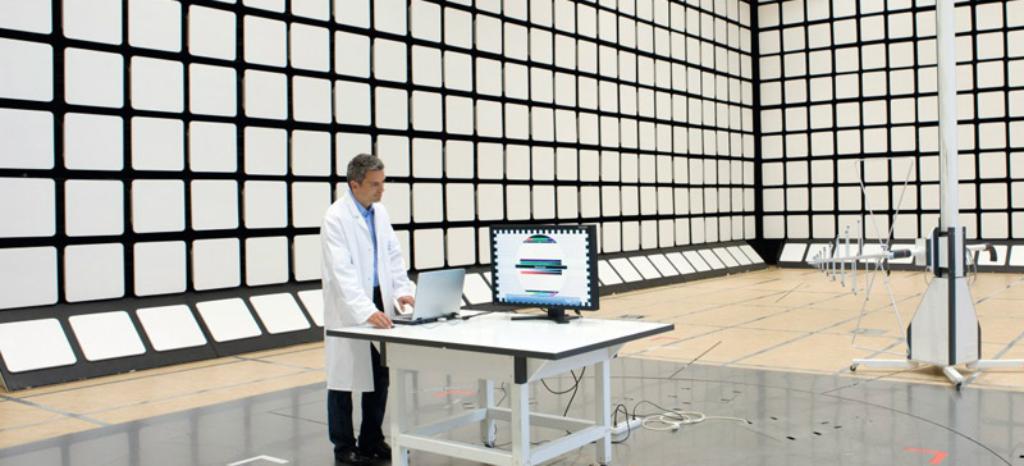Electromagnetic Compatibility (EMC) Testing and Its Importance
With the increasing use of electronic devices, the concepts of electromagnetic interference (EMI) and compatibility (EMC) are becoming more important. EMC (Electromagnetic Compatibility) refers to a series of tests conducted to ensure that a device works harmoniously with other devices in an electromagnetic environment. Electronic devices generate electromagnetic fields that can affect each other, leading to unwanted interference. EMC testing is a crucial step in preventing such interactions and ensuring that devices operate reliably.
Necessity of EMC Testing
As electrical and electronic devices become more complex, EMC testing is mandatory. These tests are important not only for consumer electronics but also for critical industries such as automotive, aerospace, defense, telecommunications, and medical devices. If aircraft, ships, military equipment, and industrial facilities are not subjected to EMC testing, serious safety risks can arise.
EMC tests address two fundamental issues:
-
Electromagnetic Interference (EMI): Preventing a device from emitting signals that could damage other electronic systems in the surrounding environment.
-
Electromagnetic Immunity: Ensuring that a device can resist external electromagnetic signals.
Devices released to the market without these tests may affect sensitive electronic systems, disrupt radio frequencies, and cause malfunctions in critical infrastructure.
EMC Test Standards and Application Areas
EMC test standards are procedures set by international, national, and industrial regulatory bodies. These standards are established to determine whether electronic devices are suitable for their operating environments.
The main organizations that establish EMC test standards include:
- IEC (International Electrotechnical Commission)
- CISPR (International Special Committee on Radio Interference)
- FCC (Federal Communications Commission)
- MIL-STD (Military Standards)
- EN Standards (European Norms)
These standards are applied across various sectors, ranging from medical devices to automotive systems, telecommunications equipment to defense industries. EMC tests are essential for verifying that a device complies with the legal requirements of the target markets.
Types of EMC Tests
EMC tests are divided into two main categories:
-
Emission Tests: Measures the electromagnetic energy emitted by a device into the environment.
-
Immunity Tests: Assesses the device's ability to withstand external electromagnetic signals.
Emission Tests
Emission tests analyze the electromagnetic radiation emitted by a device during its operation. These tests include:
-
Conducted Emissions: Measures the electromagnetic energy that the device returns to the electrical grid via its power cables.
-
Radiated Emissions: Determines the electromagnetic radiation emitted by the device through the air. This test is important to prevent the device from interfering with other devices in the vicinity.
Immunity Tests
Immunity tests evaluate the device's ability to resist external electromagnetic signals. These tests include:
-
Electrostatic Discharge (ESD): Measures the device's response to static electricity discharges that may occur from human touch or contact with other objects.
-
Radiation Immunity: Tests the device's response when exposed to different electrical fields.
-
Surge Test: Examines how the device reacts to sudden voltage spikes.
-
Conducted Immunity Test: Measures the device's sensitivity to electromagnetic interference via power lines.
-
Voltage Dips and Interruptions: Assesses whether the device can continue to function despite power supply fluctuations.
Role of EMC Testing in Product Development
EMC testing should be applied early in the product development process. These tests help identify potential flaws and design deficiencies before the product is released to the market. A successful EMC test provides the following benefits:
- Increases the device’s reliability.
- Reduces production costs.
- Minimizes service and maintenance expenses.
- Decreases warranty-related failures.
- Accelerates the go-to-market process and meets regulatory requirements.
Manufacturers can enhance customer trust and achieve long-term success by complying with EMC testing. An EMC-compliant device offers significant advantages in terms of accessing broader markets and meeting international standards.

Where Can EMC Testing Be Performed?
Electromagnetic compatibility (EMC) tests can be conducted in two main locations: your own test center or an authorized testing laboratory. Testing at your own center helps you receive quick feedback while inspecting your product. Additionally, you can quickly propose solutions to any issues that arise. On the other hand, testing in an approved laboratory provides a more comprehensive and professional evaluation.
Differences Between EMI and EMC
EMI (Electromagnetic Interference) and EMC (Electromagnetic Compatibility) are related but distinct concepts. EMI refers to the electromagnetic noise emitted by electronic devices that can harm surrounding devices. EMC, on the other hand, ensures that devices can work harmoniously with each other and remain resistant to electromagnetic effects. While EMI refers to noise emitted in specific frequency ranges, EMC refers to a device's ability to function without being affected by this noise.
Radiated EMI moves through the air, while conducted EMI is transferred through a conductor. EMC ensures that devices can operate with minimal interaction with these electromagnetic fields.
Why Are EMC Tests Necessary?
Protection of the Electromagnetic Spectrum
The electromagnetic spectrum is limited for various applications such as radio and television broadcasts and microwave communications. Due to their components, electronic devices can affect radio frequencies, which can interfere with the performance of other communication systems. Limiting the electromagnetic radiation emitted by your devices ensures the efficient use of the spectrum.
Safety and Critical Applications
Many products, especially in industries such as medical devices, automotive products, and aerospace equipment, require proper EMC testing. If these devices fail due to electromagnetic noise, it can result in significant safety risks. For example, EMC incompatibility in an aircraft system can lead to severe accidents. Therefore, EMC testing plays a vital role in ensuring safety in critical applications.
Improving Product Performance
A device's performance can be significantly influenced by environmental factors, particularly electromagnetic effects. A device with a noisy internal power supply can prevent sensitive sensors from functioning properly. Additionally, external electromagnetic noise can disrupt the device’s RF performance and data transmission. EMC testing ensures that the device remains robust against these effects, allowing it to continue performing without degradation.
Role of Test Laboratories and Regulatory Authorities
Since EMC testing can vary between laboratories, ensuring the consistency of test results is crucial. For many manufacturers, these tests can be costly, whether for large or small-scale companies. However, these tests are critical due to the regulatory authorities' requirements for inspecting devices and the potential legal sanctions involved.
Legal Penalties and Non-compliance
Failure to conduct EMC testing may subject your products to legal penalties or even sales bans. In some tests conducted within the country, a significant portion of products were found to be non-compliant. Therefore, EMC testing ensures that devices enter the market in a compliant manner, minimizing legal risks.
Safety and User Protection
Another important purpose of EMC testing is to ensure user safety. For devices to operate safely, they must be resistant to electromagnetic effects. These tests ensure that users can operate devices safely, preventing severe accidents.
Regulations and Legal Requirements
There are numerous legal regulations that mandate EMC testing. These tests not only improve the quality of products but also ensure compliance with legal requirements. Products that do not undergo EMC testing may face various penalties.
Ensuring EMC Compliance in the Design Phase
Achieving Compatibility in the Design Process
EMC compliance is a critical issue to address during the design process. The high rate of non-compliance in industries shows that designers must pay attention to this factor. In sectors such as automotive and medical devices, non-compliance can lead to significant problems. By considering EMC testing during the design phase, it is possible to make devices safer and more compatible.
Tools Supporting the Testing Process
Designers can use various tools and software to ensure EMC compliance. These tools help detect potential electromagnetic incompatibilities, allowing for corrective actions before testing. This way, designers can test the safety of their devices before bringing them to market.

Design Aids for EMC Testing
1. Use Grounding Effectively
A crucial method for ensuring EMI (Electromagnetic Interference) control and achieving EMC (Electromagnetic Compatibility) goals is to use an effective grounding system. This minimizes ground loops and ground bounce, ensuring that your device is less susceptible to electromagnetic interference. Proper grounding enhances the stability of the device, providing a cleaner operating environment.
2. Apply Filtering
In devices like switched-mode power supplies and high-power panels, voltage regulation and noise management are critical for meeting EMC test requirements. Filtering is one of the most effective methods to prevent noise in such devices and ensure they remain resilient to external influences. Filters block high-frequency electromagnetic waves from entering the device.
3. Include Test Points in the Design
Strategically placed test points in the design phase make testing easier during the development process. These test points are used to check if the device is functioning correctly and allow for more comprehensive testing in later stages. Including these test points in the design phase accelerates the design process and helps detect potential issues early.
4. Use Shielding When Appropriate
Shielding is a vital component for high-power radiators and sensitive electronic devices. It prevents the emission of electromagnetic noise and helps protect the device from external environmental effects. Applying appropriate shielding techniques based on the application's requirements enhances the device’s EMC compatibility.
Incorporating these design aids into your device's development process will ensure success in EMC testing. However, the most effective approach is to conduct an EMC analysis during the design phase. This analysis allows you to make necessary changes before building the boards, saving both time and costs.
Why is Electromagnetic Compatibility Testing (EMC) Necessary?
Electromagnetic compatibility is crucial for ensuring that modern electronic devices operate safely and effectively. Although not as commonly discussed in media as topics like food safety or children’s toys, many products have been recalled or withdrawn from the market due to electromagnetic compatibility issues. This can tarnish a brand's reputation. Electromagnetic compatibility and RF (Radio Frequency) regulations play a significant role in preventing such issues.
Legalities of Electromagnetic Compatibility Testing (EMC)
The UK government introduced laws in 1992 requiring all electronic goods manufacturers and their products to ensure electromagnetic compatibility. These laws were enacted to ensure that electronic products operate safely and in compliance with regulations.
Moreover, commercial users expect the products they purchase to carry the CE mark. The CE mark indicates that the product complies with all relevant regulations in the European Union, including passing necessary safety tests such as EMC testing.
Current legislation offers manufacturers two primary ways to prove EMC compliance:
1. Declaration of Conformity
This is the process by which, following EMC testing against relevant standards, a product obtains the European Union Declaration of Conformity. This declaration certifies that the product meets all the necessary requirements, confirming that it is safe and complies with legal regulations.
2. Technical Construction File
Alternatively, a test plan determined by an Authorized Body, often based on an alternative or reduced testing plan, is reviewed, and all relevant documents are submitted to the organization as a Technical Construction File. This file proves the product’s EMC compliance and safety.
In the case of a legal dispute, manufacturers can demonstrate that they have taken all reasonable precautions and tested their products correctly. Conducting EMC tests serves as a strong defense in proving that manufacturers have taken all the necessary steps to comply with legal regulations.

How Electromagnetic Compatibility Testing Reduces Risk
Electromagnetic compatibility (EMC) testing is the most reliable way for manufacturers to assess the electromagnetic compatibility of their products. However, since EMC is an abstract phenomenon, it is difficult to determine the extent to which devices are affected by electromagnetic influences or how much they affect other devices. EMC tests play a critical role in mitigating these risks. These tests measure whether products are resistant to potential electromagnetic interference while also controlling the electromagnetic emissions they radiate.
These tests should be conducted during the production phase, especially for new devices and prototypes. After modifications are made during production, these tests may need to be repeated. Products must always be designed in compliance with specific EMC standards and must meet these standards. Testing is an important tool for verifying that products meet market requirements.
Declaration of Conformity and OEM Parts
The primary goal of EMC testing is to ensure that products comply with all necessary safety and compatibility standards. In particular, the Declaration of Conformity (DoC) for Original Equipment Manufacturer (OEM) parts is of great importance. This document confirms that the manufacturer has ensured that the product complies with certain EMC standards. These documents are especially crucial for new products or additional accessories.
Another factor to consider during this process is whether the final product's design is suitable for the intended usage conditions. Manufacturers can prove compliance by conducting these tests before releasing their products to the market.
Civil Testing and EMC Applications
EMC tests include specific tests for various devices across different industries. These tests primarily focus on measuring the device's resistance to electromagnetic interference in its environment. Here are some common civil tests:
Electrostatic Discharge Immunity Test
This test measures how resistant devices are to electrostatic discharge, which can damage their circuits.
Glow Electromagnetic Field Immunity Test
This test assesses how devices respond to electromagnetic interference from surrounding electromagnetic fields, simulating their impact on the device.
Electrical Fast Transient/ Burst Immunity Test
This test measures how resistant devices are to brief voltage changes. Fast transients are common in electrical systems and can disrupt devices.
Surge Immunity Test
This test evaluates the performance of devices during emergency conditions, measuring their response to power loss or sudden power fluctuations.
RF Field Immunity Test
This test evaluates a device’s immunity to interference from radio frequency (RF) fields, which can disrupt communication performance.
Power Frequency Magnetic Field Immunity Test
This test evaluates how resistant the device is to magnetic fields from the electrical grid. It measures the resistance to magnetic interference coming through the power supply.
Magnetic Field Pulse Immunity Test
This test determines how resistant a device is to magnetic pulses, which could impact its performance.
How to Determine Whether a Device Passes EMC Testing
For manufacturers, EMC testing is the most reliable way to determine if their products are resistant to electromagnetic interference and whether the electromagnetic emissions they release are controlled. Using proven design techniques like filtering, sealing design, and shielding in product design increases the likelihood of passing EMC testing. These techniques enhance the device’s electromagnetic resilience and ensure its safety.
Additional tests are conducted in various test chambers for innovative designs. These tests are critical for validating new concepts and ensuring they are properly filtered. Furthermore, when products have high transition rates, testing performed during the design phase can shorten approval timelines and result in a safer product.
Devices Required to Undergo EMC Testing
EMC testing is mandatory not only for specific devices but for all electrical and electronic devices. This includes industrial manufacturing equipment, radio receivers, wireless devices, mobile phones, household appliances, electrical devices, televisions, and computers. Before these devices are released to the market, they must undergo EMC testing to ensure environmental compatibility and user safety.
EMC testing evaluates the emission (the ability to emit electromagnetic interference) and immunity (the ability to withstand interference) properties of devices. These evaluations determine whether the device is environmentally compatible and verify that the product can operate safely.
EMC Testing Principles and Methods
The foundation of EMC testing revolves around two main groups: emission (electromagnetic interference) and immunity (resistance to interference). These tests identify whether the device generates electromagnetic interference and how resistant it is to external factors.
Emission Testing Methods
Emission tests include measuring electromagnetic radiation, parasitic voltage waves, and power of the waves emitted. These tests assess whether the interference from the device affects other surrounding devices.
Immunity Testing Methods
Immunity tests evaluate the device’s resistance to static electricity discharges, sudden voltage fluctuations, radiation effects, power surges, and power interruptions.
Different Testing Environments
There are four main test environments used for EMC testing:
- Semi-Anechoic Room: Some electromagnetic waves are reflected, and others are absorbed.
- Shielded Room: A controlled environment that blocks external electromagnetic interference (similar to a Faraday cage).
- Open Area Test Site: Tests conducted in open spaces measure the electromagnetic effects emitted by the device.
- Fully Anechoic Room: All electromagnetic waves are absorbed, allowing for more precise measurements.
EMC testing involves different test limits, methods, and features for each device, all designed to determine whether the device is safe and compliant with environmental standards. In general, immunity and emission tests cover these two categories and help evaluate whether the device operates safely in its environment.







